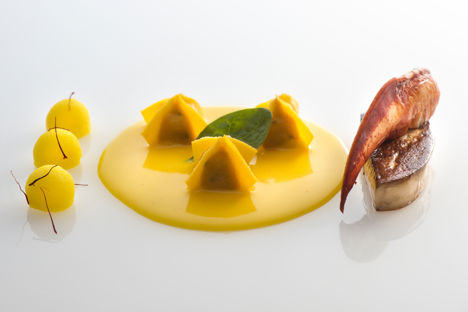
Move over penne – reinventing pasta with Italy’s best chefs
Pasta’s popularity shows no sign of waning but Italy’s finest chefs are elevating this homely staple to new heights by giving it the fine dining treatment.
Move over penne – reinventing pasta with Italy’s best chefs
Pasta’s popularity shows no sign of waning but Italy’s finest chefs are elevating this homely staple to new heights by giving it the fine dining treatment.
Apparently there are over 300 different pasta shapes in Italy and some say that this is still an underestimation. There is no doubt that Italians love this staple carbohydrate and it is served in every home and local ristorante with different shapes and sauces depending on the region you find yourself in. At the very top end of Italy’s culinary spectrum in the Michelin-starred establishments, pasta is also on the menu but this is pasta at its most refined. Forget Bolognese, carbonara and lasagne, pasta is having a makeover.
Filled pasta
Every region of Italy has its own traditional version of stuffed pasta which is why there are so many variations in shape, stuffing and sauce but while the classic fillings are still popular (think spinach and ricotta ravioli or Parmesan and prosciutto tortellini), Italian chefs are filling little pasta parcels with all sorts of unexpected and indulgent ingredients to make them more sophisticated and elegant than home-made versions. For an incredibly decadent ravioli, look at Gaetano Trovato’s lobster and sea bream version which is served with foie gras, fresh lobster and saffron potatoes. Andrea Sarri makes cappelletti with slow-cooked rabbit, Parmesan and chard for a rich, pleasing starter while Aurora Mazzucchelli blurs the boundaries between sweet and savoury by filling tortelli with Parmesan and lavender and serving them with almonds, borage flowers and a nutmeg sauce. With lots of different shapes and endless filling possibilities, the only limit is imagination.
Flavoured pasta
Adding unexpected ingredients to the pasta itself is a clever way to introduce new flavours or colours to a dish. I’m not talking about the multi-coloured pasta shapes you can buy in delis which look splendid but invariably taste of nothing. These freshly made colourful pastas taste and look really vibrant and take homely pasta dishes to a whole new level. Rosanna Marziale uses black squid ink tagliatelle to add drama to her squid and mussel dish while Emanuele Scarello livens up the plate by cooking his macaroni in beetroot juice – the pasta becomes a powerful pink and tastes glorious. Francesco Sposito makes his fettucine with pistachio flour for a nutty flavour and texture and serves it with mortadella emulsion and leek powder while Alessandro Gavagna adds a mixture of chopped herbs to his pasta dough for his simple, green spaghettini. Other ingredients that can be added include saffron, chillies, dried peppers or even chocolate.
Not pasta at all
In contemporary restaurants across Italy, some chefs are doing away with pasta all together, replacing it with ingredients that behave a little like it. Similar to the recent trend for courgetti – ‘spaghetti’ made from spiralized courgette – squid and cuttlefish can be cut into very fine ribbons and served with sauce. Mario Uliassi does this for his Tagliatelle of cuttlefish with nori pesto and fried quinoa while Francesco Sposito uses squid for his alternative tagliatelle which he serves with dehydrated squid ink. Other possible ingredients for spiralizing are carrots, beetroot, celeriac, cucumber, sweet potatoes and kohlrabi. Similarly, vegetables and fruit that can be cut very finely while still retaining their shape can be used to make ravioli. You could try using turnip, kohlrabi, beetroot, mango or pineapple to make little parcels filled with complementary flavours. For a very sophisticated sweet version have a look at Aurora Mazzucchelli’s Pineapple ravioli with ricotta which is served with coffee caviar, raisins, pine nuts and edible flowers – it’s as pretty as it is delicious and no pasta in sight.
Get in touch
Please sign in or register to send a comment to Great British Chefs.


